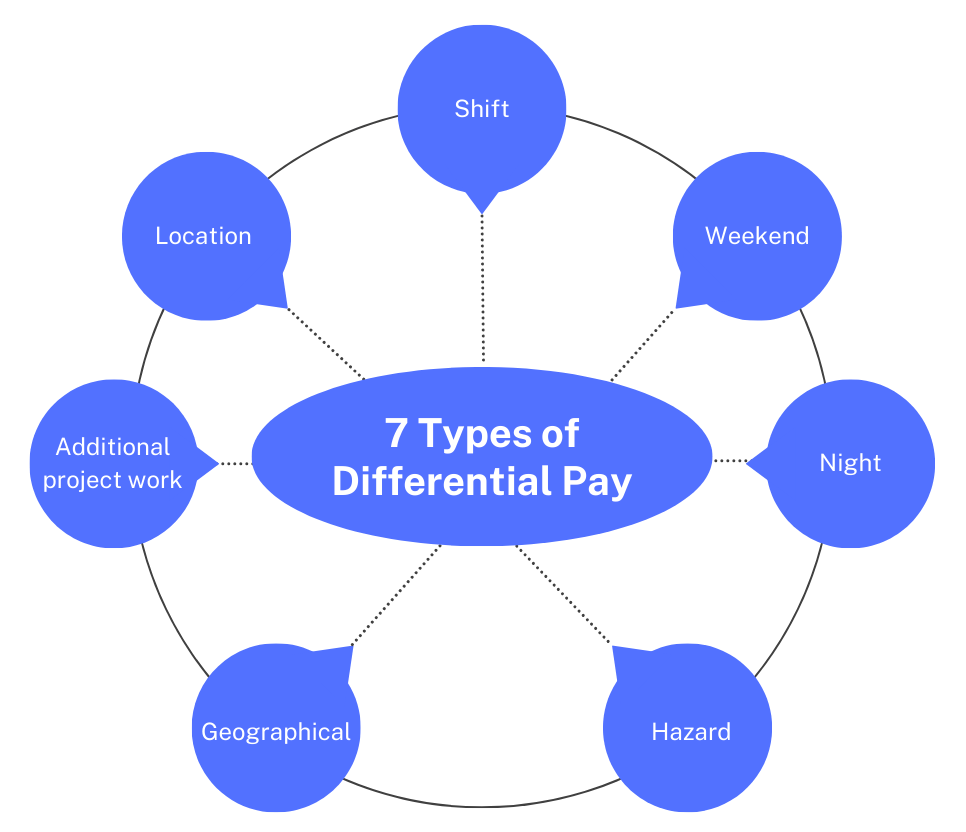An Employer’s Guide to Shift Differential Pay

Table of contents
Modern workforce management is complex. And it is no surprise that businesses face the perennial challenge of ensuring operational continuity and productivity across all hours of operation. For enterprises reliant on desktop or laptop-based tasks,optimizing workforce scheduling, especially during less desirable shifts, becomes paramount.
Shift differential pay emerges as a strategic tool in this pursuit. So, what is a shift differential? How do you calculate it? How can it benefit your business and your employees? Well, in this blog, we’re going to find answers to these questions.
What is a shift differential?
Businesses typically operate within a defined business hour. But in many cases, you might need your employees to work outside the business hours. That’s where the concept of shift differential becomes evident.
- A shift differential refers to additional compensation provided to employees for working outside the standard work hours.
- This compensation aims to recognize the inconvenience or increased effort associated with specific shifts, such as nights, weekends, or holidays.
Fact check: 49% of IT organizations and 59% of customer support and service companies offer shift differentials.
| Feature | Shift Differential Pay | Overtime |
| Purpose | Compensate for working less desirable hours (nights, weekends, holidays) | Compensate for working beyond standard hours (typically 40 hours/week) |
| Rate of Pay | Percentage or flat-rate increase on base pay (10%-25% common) | One and a half times base pay (time-and-a-half) |
| Hours Worked | Paid regardless of hours worked within eligible shift | Only applies to hours worked above the standard 40 |
| Legal Requirement | Not mandated by federal law | Mandated by Fair Labor Standards Act (FLSA) for most non-exempt employees |
| Calculation | Applied directly to base pay for all hours worked during eligible shift | Added to base pay for overtime hours only |
| Benefits for Employers | Attracts and retains employees for off-peak hours, improves staffing, boosts morale | Increases productivity during peak hours, covers unplanned work demands |
Why Do You Need To Implement Shift Differential Pay?
Attract and Retain Employees for Less Desirable Shifts
The allure of conventional work hours often overshadows the appeal of nights, weekends, or holiday shifts. Offering a shift differential pay, for example, differential pay for the night shift, becomes a compelling incentive for employees to embrace the less coveted time slots.
By acknowledging the sacrifices inherent in non-standard shifts, businesses can attract and retain a dedicated workforce willing to support operations round-the-clock.
Increase Productivity and Motivation During Off-Peak Hours
Employees compensated with shift differential pay tend to exhibit heightened motivation and productivity during non-traditional hours.
Recognizing their commitment through monetary compensation fosters a sense of appreciation and motivates them to perform optimally, contributing to sustained operational efficiency throughout all shifts.
Maintain Operational Continuity and Customer Service Levels
In industries where continuous service provision is paramount, maintaining consistent staffing levels across various shifts is crucial.
Shift differential pay encourages employees to fill critical roles during weekends, nights, or holidays, ensuring uninterrupted operations and upholding service standards to meet customer expectations.
Address Staffing Shortages Due to Shift Preferences
Employee preferences for specific shifts can lead to staffing imbalances, creating challenges in scheduling and operational flow.
Shift differential pay provides a strategic means to address these shortages by incentivizing employees to opt for less popular shifts, mitigating staffing gaps and ensuring smoother workflow transitions.
Enhance Employee Morale and Reduce Turnover
Recognizing the commitment and effort of employees working non-standard shifts goes beyond monetary compensation.
It contributes significantly to enhancing overall morale, fostering a positive work environment, and minimal turnover rates among staff assigned to less conventional work hours. Employers who fairly compensate their employees saw 56% less turnover.
How to Calculate Shift Differential Rates?
When establishing shift differential rates, several factors come into play, ensuring a fair and effective compensation structure. These factors include:
Time of Day
The degree of inconvenience associated with different times of the day influences the rate. The average night shift differential, for instance, is often higher due to its impact on employees’ circadian rhythms.
Day of Week
Weekends and holidays generally merit higher differentials, aligning with the increased disruption to employees’ personal schedules during these times.
Job Responsibilities
The complexity and demands of specific roles can influence the shift differential. Positions with higher responsibilities or specialized skills may warrant increased compensation.
Skill Level
Employees with specialized skills or qualifications may receive higher differentials, reflecting the added value they bring to less desirable shifts.
Industry Standards
Benchmarking against industry standards helps ensure competitiveness and fairness in shift differential rates.
The majority of companies, around 58%, compensate their salaried employees with an added percentage of their base salary when they work less desirable shifts.


Regional and Local Market Rates
The cost of living and prevailing wage rates in a certain region or locality should be considered to maintain parity and competitiveness.
Types of Shift Differential Rates
Shift differential pay is calculated through two methods: percentage and flat-rate differentials. So, let’s take a look at each of them:
Percentage Differentials
Calculated as a certain percentage of the employee’s base pay, this method ensures that the differential scales proportionally with salary increases.
- Advantages: Reflects the proportional impact of less desirable shifts on earnings. Aligns with salary adjustments.
- Disadvantages: This may result in lower differentials for lower-paid employees.
Flat-Rate Differentials
In this approach, a fixed amount is added to the base pay for each hour worked during a designated shift. This method provides a straightforward and predictable means of compensation.
- Advantages: Offers simplicity and predictability. Ensures a consistent additional amount for all employees.
- Disadvantages: It may not account for the proportional impact on higher-paid employees.
Businesses are almost evenly divided regarding the approach employed in computing shift differentials for hourly workers: 49% offer a flat extra amount per hour, while 47% determine the differential as a proportion of the hourly base rate.

How to Implement Shift Differential Pay?
Here’s a step-by-step guide to implementing a shift differential pay within your organization:
Develop a Clear and Transparent Policy
A robust policy is the foundation of a successful shift differential pay program. This policy should encompass:
- Eligible Shifts: Clearly outline which shifts qualify for differential pay. Specify the criteria based on time of day, days of the week, holidays, or other relevant parameters.
- Pay Rates: Define the differential rates for each eligible shift, considering the factors discussed earlier. Ensure these rates align with the company’s budget while remaining competitive.
- Calculation Methods: Explain how the differentials will be calculated (percentage or flat-rate) to ensure clarity for both employees and payroll administrators.
- Overtime Rules: Address how shift differentials interact with overtime pay. Define whether the differential is included in overtime calculations or applied separately.
- Exceptions: Outline any circumstances where the differential may not apply, ensuring transparency and fairness.
Communicating the Policy Effectively to Employees
Transparency and clarity in communication are vital to the successful implementation of a shift differential pay policy. You should consider:
- Written Materials: Create comprehensive documents explaining the policy, including handbooks or manuals accessible to all employees.
- Training Sessions: Conduct training sessions to educate employees and supervisors about the policy’s specifics, ensuring everyone understands its implications.
- Q&A Sessions: Provide forums for employees to ask questions and seek clarification, fostering a clear understanding of the policy.
Integrating the Policy into Payroll Systems and Timekeeping Software
Ensure seamless implementation by integrating the shift differential policy into payroll systems and timekeeping software.
This integration streamlines the calculation and application of differentials, reducing errors and ensuring accuracy in compensation.
Monitoring and Reviewing the Policy’s Effectiveness
Continuous evaluation is essential to gauge the policy’s impact and make necessary adjustments. Employers should:
- Track Costs: Monitor the financial impact of shift differentials to ensure they align with budgetary constraints.
- Employee Satisfaction: Gather feedback from employees to understand their perception of the policy’s fairness and effectiveness.
- Staffing Metrics: Analyze staffing data to assess if the policy effectively addresses staffing shortages during less desirable shifts.
Legal and Compliance Considerations
When implementing shift differential pay, employers must ensure compliance with minimum wage and overtime regulations stated in the Fair Labor Standards Act (FLSA). You also need to comply with state regulations.
Key considerations include:
- Minimum Wage Compliance: Shift differentials should not bring an employee’s effective hourly wage below the mandated minimum wage for all hours worked.
- Overtime Calculations: Determine how shift differentials factor into overtime calculations, ensuring compliance with overtime laws, such as the Fair Labor Standards Act (also known as FLSA) and relevant state regulations.
Read Also: Shift Work Scheduling: Fundamentals, Challenges, and Benefits
Best Practices for Managing Shift Differential Pay
Embracing best practices for shift differential pay helps to keep your employees happy while ensuring you stay competitive in the market. Wondering what these are? Let’s take a look:
Review Compensation Data
Periodically audit compensation records to verify the accurate application of shift differentials and adherence to policy guidelines. Promptly address any discrepancies or inconsistencies in compensation, ensuring fairness and compliance.
Explore Flexible Scheduling
Offer options for flexible schedules or shift swaps to accommodate employee preferences while maintaining operational needs.
Consider Alternative Shift Structures
Experiment with alternative shift structures, such as compressed workweeks or staggered shifts, to optimize employee coverage across hours of operation.
Focus on Performance
Recognize and reward high performing employees based on their contributions and achievements during less conventional shifts.
Promote Inclusivity
Emphasize inclusivity and equal opportunities for career growth and development for employees working in different shifts.
Wrapping up
Navigating shift differential pay requires a strategic approach that addresses the requirement of both employers and employees.
ProHance is a workforce analytics and operations enablement platform that offers a holistic view of operations, identifying opportunities for collaboration and optimization across the enterprise.
If you’re seeking enhanced workforce efficiency, streamlined operations, and actionable insights to drive productivity, you can benefit from the comprehensive capabilities offered by ProHance.
Book a consultation with us today!
Frequently Asked Questions
Q1. What is a shift differential?
A shift differential is the additional pay given to employees for working during less desirable hours, compensating for the inconvenience or increased effort associated with those shifts.
Q2. How do I calculate shift differential pay for night shifts?
To calculate the average night shift differential, subtract the regular hourly rate from the night shift rate and then multiply the difference by the number of hours worked during the night shift.
Q3. What is the average night shift differential?
The average night shift differential varies based on company policies, industry standards, and geographical locations. It typically ranges from a percentage increase to a fixed hourly rate above the standard pay for day shifts.



